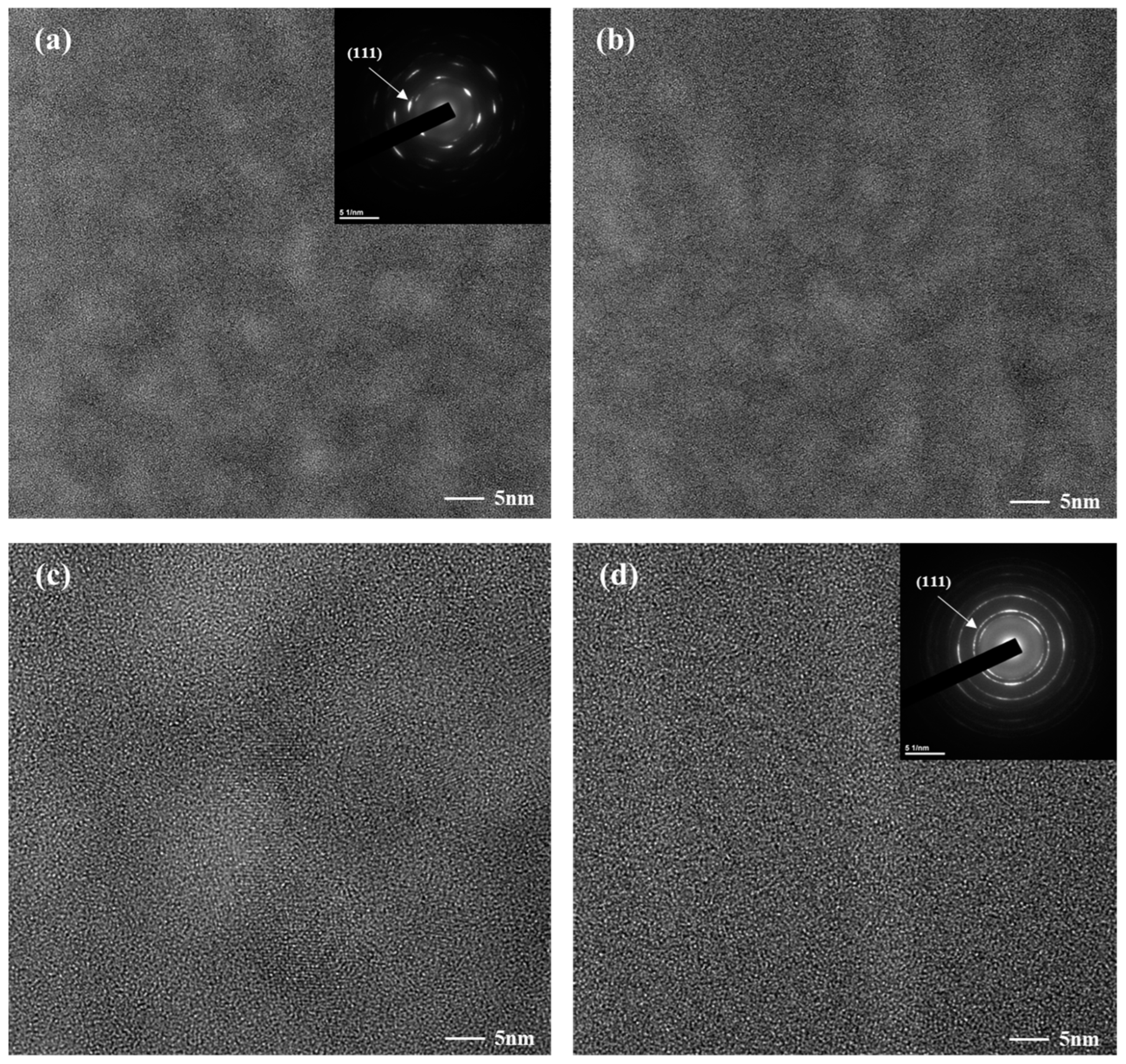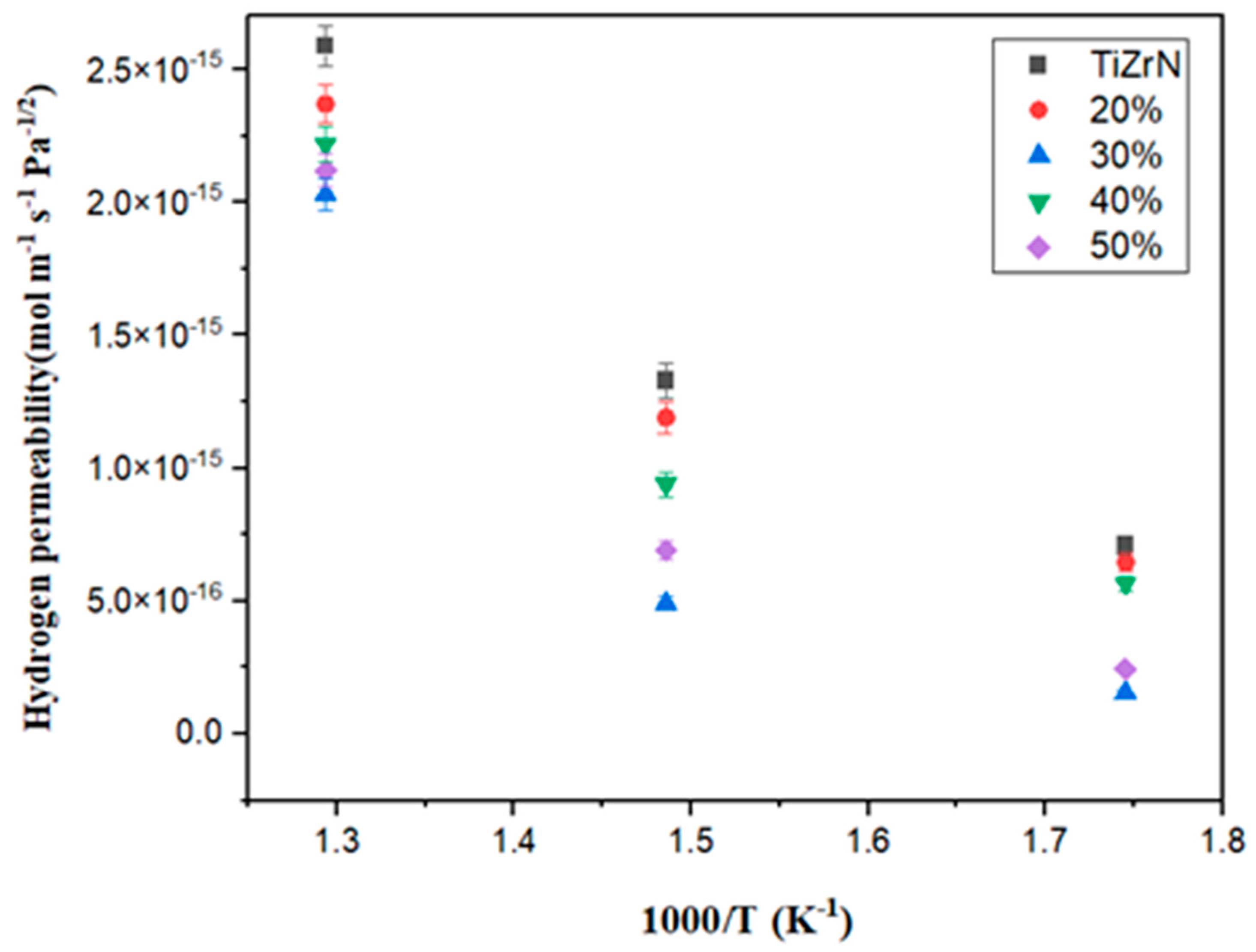The Bonding State and Surface Roughness of Carbon-Doped TiZrN Coatings for Hydrogen Permeation Barriers
Abstract
:1. Introduction
2. Materials and Methods
3. Results and Discussion
4. Conclusions
Author Contributions
Funding
Conflicts of Interest
References
- Kim, C.; Cho, S.H.; Cho, S.M.; Na, Y.; Kim, S.; Kim, D.K. Review of hydrogen infrastructure: The current status and roll-out strategy. Int. J. Hydrog. Energy 2023, 48, 1701–1716. [Google Scholar] [CrossRef]
- Noh, H.; Kang, K.; Seo, Y. Environmental and energy efficiency assessments of offshore hydrogen supply chains utilizing compressed gaseous hydrogen, liquefied hydrogen, liquid organic hydrogen carriers and ammonia. Int. J. Hydrog. Energy 2023, 48, 7515–7532. [Google Scholar] [CrossRef]
- Sazali, N. Emerging technologies by hydrogen: A review. Int. J. Hydrog. Energy 2020, 45, 18753–18771. [Google Scholar] [CrossRef]
- Dwivedi, S.K.; Vishwakarma, M. Hydrogen embrittlement in different materials: A review. Int. J. Hydrog. Energy 2018, 43, 21603–21616. [Google Scholar] [CrossRef]
- Song, J.; Curtin, W. A nanoscale mechanism of hydrogen embrittlement in metals. Acta Mater. 2011, 59, 1557–1569. [Google Scholar] [CrossRef]
- Lynch, S. Hydrogen embrittlement phenomena and mechanisms. Corros. Rev. 2012, 30, 105–123. [Google Scholar] [CrossRef]
- Karlsdottir, S.N. Corrosion, Scaling and Material Selection in Geothermal Power Production; Elsevier Ltd.: Amsterdam, The Netherlands, 2022. [Google Scholar]
- Oldfield, J.W.; Sutton, W.H. Crevice corrosion of stainless steels: II. Experimental studies. Br. Corros. J. 1978, 13, 104–111. [Google Scholar] [CrossRef]
- Xiao, S.; Meng, X.; Shi, K.; Liu, L.; Wu, H.; Lian, W.; Zhou, C.; Lyu, Y.; Chu, P.K. Hydrogen permeation barriers and preparation techniques: A review. J. Vac. Sci. Technol. A 2022, 40, 060803. [Google Scholar] [CrossRef]
- Kura, C.; Kunisada, Y.; Tsuji, E.; Zhu, C.; Habazaki, H.; Nagata, S.; Müller, M.P.; De Souza, R.A.; Aoki, Y. Hydrogen separation by nanocrystalline titanium nitride membranes with high hydride ion conductivity. Nat. Energy 2017, 2, 786–794. [Google Scholar] [CrossRef]
- Yang, X.; Gao, Z.; Wang, X.; Hu, W. Influence of fusion bonded epoxy powder on Corrosion, wear performance of galvanized composite coating and hydrogen permeation behavior to based carbon steel. Mater. Lett. 2021, 296, 129922. [Google Scholar] [CrossRef]
- Tamura, M.; Eguchi, T. Nanostructured thin films for hydrogen-permeation barrier. J. Vac. Sci. Technol. A 2015, 33, 41503. [Google Scholar] [CrossRef]
- Tamura, M. Hydrogen permeation characteristics of TiN-Coated stainless steels. J. Mater. Sci. Eng. 2015, 5, 197–201. [Google Scholar]
- Tamura, M.; Takizawa, H. TiAlN/TiMoN Coatings as Hydrogen Barriers. J. Mater. Sci. Eng. A 2019, 9, 1–7. [Google Scholar]
- Wang, J.; Li, Q.; Xiang, Q.-Y.; Cao, J.-L. Performances of AlN coatings as hydrogen isotopes permeation barriers. Fusion Eng. Des. 2016, 102, 94–98. [Google Scholar] [CrossRef]
- Guikai, Z.; Ju, L.; Chang’an, C.; Sanping, D.; Guoping, L. Tritium permeation barrier-aluminized coating prepared by Al-plating and subsequent oxidation process. J. Nucl. Mater. 2011, 417, 1245–1248. [Google Scholar] [CrossRef]
- Djafer, A.Z.A.; Saoula, N.; Madaoui, N.; Zerizer, A. Deposition and characterization of titanium carbide thin films by magnetron sputtering using Ti and TiC targets. Appl. Surf. Sci. 2014, 312, 57–62. [Google Scholar] [CrossRef]
- Yate, L.; Coy, L.E.; Wang, G.; Beltrán, M.; Díaz-Barriga, E.; Saucedo, E.M.; Ceniceros, M.A.; Załęski, K.; Llarena, I.; Möller, M.; et al. Tailoring mechanical properties and electrical conductivity of flexible niobium carbide nanocomposite thin films. RSC Adv. 2014, 4, 61355–61362. [Google Scholar] [CrossRef]
- Bressan, J.D.; Hesse, R.; Silva, E.M., Jr. Abrasive wear behavior of high speed steel and hard metal coated with TiAlN and TiCN. Wear 2001, 250, 561–568. [Google Scholar] [CrossRef]
- Chuan, S.P.; Ghani, J.A.; Tomadi, S.H.; Hassan, C.H.C. Analysis of Ti-base Hard Coating Performance in Machining Process: A Review. J. Appl. Sci. 2012, 12, 1882–1890. [Google Scholar] [CrossRef]
- Ghareshabani, E.; Rawat, R.S.; Sobhanian, S.; Verma, R.; Karamat, S.; Pan, Z.Y. Synthesis of nanostructured multiphase Ti (C, N)/aC films by a plasma focus device. Nucl. Instrum. Methods Phys. Res. B 2010, 268, 2777–2784. [Google Scholar] [CrossRef]
- Robertson, J. Amorphous carbon. Adv. Phys. 1986, 35, 317–374. [Google Scholar] [CrossRef]
- Bhushan, B. Tribology: Friction, wear, and lubrication. In The Engineering Handbook; CRC Press: Boca Raton, FL, USA, 2000; pp. 80–120. [Google Scholar]
- Yang, Y.; Yan, M.; Zhang, Y.; Zhang, C.; Wang, X. Self-lubricating and anti-corrosion amorphous carbon/Fe3C composite coating on M50NiL steel by low temperature plasma carburizing. Surf. Coat. Technol. 2016, 304, 142–149. [Google Scholar] [CrossRef]
- Rotundo, F.; Ceschini, L.; Martini, C.; Montanari, R.; Varone, A. High temperature tribological behavior and microstructural modifications of the low-temperature carburized AISI 316L austenitic stainless steel. Surf. Coat. Technol. 2014, 258, 772–781. [Google Scholar] [CrossRef]
- Angelini, V.; Boromei, I.; Martini, C.; Scheuer, C.; Cardoso, R.; Brunatto, S.; Ceschini, L. Dry sliding behavior (block-on-ring tests) of AISI 420 martensitic stainless steel, surface hardened by low temperature plasma-assisted carburizing. Tribol. Int. 2016, 103, 555–565. [Google Scholar] [CrossRef]
- Neuville, S. New application perspective for tetrahedral amorphous carbon coatings. QScience Connect. 2014, 2014. [Google Scholar] [CrossRef]
- Mattioli, S.; Peltzer, M.; Fortunati, E.; Armentano, I.; Jiménez, A.; Kenny, J. Structure, gas-barrier properties and overall migration of poly(lactic acid) films coated with hydrogenated amorphous carbon layers. Carbon 2013, 63, 274–282. [Google Scholar] [CrossRef]
- Polonskyi, O.; Kylián, O.; Petr, M.; Choukourov, A.; Hanuš, J.; Biederman, H. Gas barrier properties of hydrogenated amorphous carbon films coated on polyethylene terephthalate by plasma polymerization in argon/n-hexane gas mixture. Thin Solid Films 2013, 540, 65–68. [Google Scholar] [CrossRef]
- Kousaka, H.; Mori, K.; Umehara, N.; Tamura, N.; Shindo, T. Internal DLC coating of narrow metal tubes using high-density near plasma sustained by microwaves propagating along plasma–sheath interfaces. Surf. Coat. Technol. 2013, 229, 65–70. [Google Scholar] [CrossRef]
- Tamura, Y.; Zhao, H.; Wang, C.; Morina, A.; Neville, A. Interaction of DLC and B4C coatings with fully formulated oils in boundary lubrication conditions. Tribol. Int. 2016, 93, 666–680. [Google Scholar] [CrossRef]
- Kim, S.; Kim, T.; Hong, E.; Jo, I.; Kim, J.; Lee, H. Phase Formation and Wear Resistance of Carbon-Doped TiZrN Nanocomposite Coatings by Laser Carburization. Metals 2021, 11, 590. [Google Scholar] [CrossRef]
- Hong, E.; Kim, T.; Kim, S.; Lee, S.; Lee, H. Carbon depth profile and internal stress by thermal energy variation in carbon-doped TiZrN coating. J. Am. Ceram. Soc. 2021, 104, 564–571. [Google Scholar] [CrossRef]
- ISO 15105-1; ISO Standard, Plastics–Film and Sheeting–Determination of Gas-Transmission Rate–Part 1: Differential Pressure Methods. ISO: Geneva, Switzerland, 2007.
- Chinsakolthanakorn, S.; Buranawong, A.; Witit-Anun, N.; Chaiyakun, S.; Limsuwan, P. Characterization of Nanostructured TiZrN Thin Films Deposited by Reactive DC Magnetron Co-sputtering. Procedia Eng. 2012, 32, 571–576. [Google Scholar] [CrossRef]
- He, K.; Chen, N.; Wang, C.; Wei, L.; Chen, J. Method for Determining Crystal Grain Size by X-ray Diffraction. Cryst. Res. Technol. 2018, 53, 157. [Google Scholar] [CrossRef]
- Roy, A.; Mukhopadhyay, A.K.; Das, S.C.; Bhattacharjee, G.; Majumdar, A.; Hippler, R. Surface Stoichiometry and Optical Properties of Cux–TiyCz Thin Films Deposited by Magnetron Sputtering. Coatings 2019, 9, 551. [Google Scholar] [CrossRef]
- Dwivedi, N.; Yeo, R.J.; Satyanarayana, N.; Kundu, S.; Tripathy, S.; Bhatia, C.S. Understanding the Role of Nitrogen in Plasma-Assisted Surface Modification of Magnetic Recording Media with and without Ultrathin Carbon Overcoats. Sci. Rep. 2015, 5, 7772. [Google Scholar] [CrossRef]
- Li, X.; Zhang, D.; Lee, K.-R.; Wang, A. Effect of metal doping on structural characteristics of amorphous carbon system: A first-principles study. Thin Solid Films 2016, 607, 67–72. [Google Scholar] [CrossRef]
- Liu, D.; Zheng, L.; Liu, J.; Luo, L.; Wu, Y. Residual stress relief of hard a-C films though buckling. Ceram. Int. 2018, 44, 3644–3648. [Google Scholar] [CrossRef]
- Tengstrand, O.; Nedfors, N.; Andersson, M.; Lu, J.; Jansson, U.; Flink, A.; Eklund, P.; Hultman, L. Model for electron-beam-induced crystallization of amorphous Me–Si–C (Me = Nb or Zr) thin films. J. Mater. Res. 2014, 29, 2854–2862. [Google Scholar] [CrossRef]
- Lin, Z.; Cai, L.; Lu, W.; Chai, Y. Phase and Facet Control of Molybdenum Carbide Nanosheet Observed by In Situ TEM. Small 2017, 13, 1700051. [Google Scholar] [CrossRef]
- Kim, T.; Lee, J.; Kim, S.; Hong, E.; Lee, H. Hydrogen permeation barrier of carbon-doped TiZrN coatings by laser carburization. Corros. Sci. 2021, 190, 109700. [Google Scholar] [CrossRef]
- Belova, I.V.; Murch, G.E.; Fiedler, T. The Harrison Diffusion Kinetics Regimes in Grain Boundary Diffusion: Lattice Monte Carlo Modelling of the Effect of Segregation, In Defect and Diffusion Forum; Trans Tech Publications Ltd.: Stafa-Zurich, Switzerland, 2011; Volume 309, pp. 9–18. [Google Scholar]
- Wang, F.; Liang, L.; Shi, L.; Liu, M.; Sun, J. CO2-assisted synthesis of mesoporous carbon/C-doped ZnO composites for enhanced photocatalytic performance under visible light. Dalton Trans. 2014, 43, 16441–16449. [Google Scholar] [CrossRef] [PubMed]
- Wan, L.; Geng, W.T.; Ishii, A.; Du, J.-P.; Mei, Q.; Ishikawa, N.; Kimizuka, H.; Ogata, S. Hydrogen embrittlement controlled by reaction of dislocation with grain boundary in alpha-iron. Int. J. Plast. 2019, 112, 206–219. [Google Scholar] [CrossRef]





| Laser Output | Lattice Constant | Grain Size |
|---|---|---|
| 0% (TiZrN) | 4.312 Å | 26.49 nm |
| 20% | 4.348 Å | 25.78 nm |
| 30% | 4.366 Å | 24.45 nm |
| 40% | 4.388 Å | 20.14 nm |
| 50% | 4.402 Å | 18.31 nm |
| Laser Output | Carbide | Sp2/Sp3 Ratio |
|---|---|---|
| 20% | 4% | 1.23 |
| 30% | 6.2% | 1.31 |
| 40% | 6.9% | 2.64 |
| 50% | 7.5% | 2.89 |
Disclaimer/Publisher’s Note: The statements, opinions and data contained in all publications are solely those of the individual author(s) and contributor(s) and not of MDPI and/or the editor(s). MDPI and/or the editor(s) disclaim responsibility for any injury to people or property resulting from any ideas, methods, instructions or products referred to in the content. |
© 2023 by the authors. Licensee MDPI, Basel, Switzerland. This article is an open access article distributed under the terms and conditions of the Creative Commons Attribution (CC BY) license (https://creativecommons.org/licenses/by/4.0/).
Share and Cite
Kim, S.; Kim, T.; Lee, S.; Lee, H. The Bonding State and Surface Roughness of Carbon-Doped TiZrN Coatings for Hydrogen Permeation Barriers. Nanomaterials 2023, 13, 2905. https://doi.org/10.3390/nano13212905
Kim S, Kim T, Lee S, Lee H. The Bonding State and Surface Roughness of Carbon-Doped TiZrN Coatings for Hydrogen Permeation Barriers. Nanomaterials. 2023; 13(21):2905. https://doi.org/10.3390/nano13212905
Chicago/Turabian StyleKim, Seonghoon, Taewoo Kim, Seungjae Lee, and Heesoo Lee. 2023. "The Bonding State and Surface Roughness of Carbon-Doped TiZrN Coatings for Hydrogen Permeation Barriers" Nanomaterials 13, no. 21: 2905. https://doi.org/10.3390/nano13212905
APA StyleKim, S., Kim, T., Lee, S., & Lee, H. (2023). The Bonding State and Surface Roughness of Carbon-Doped TiZrN Coatings for Hydrogen Permeation Barriers. Nanomaterials, 13(21), 2905. https://doi.org/10.3390/nano13212905






